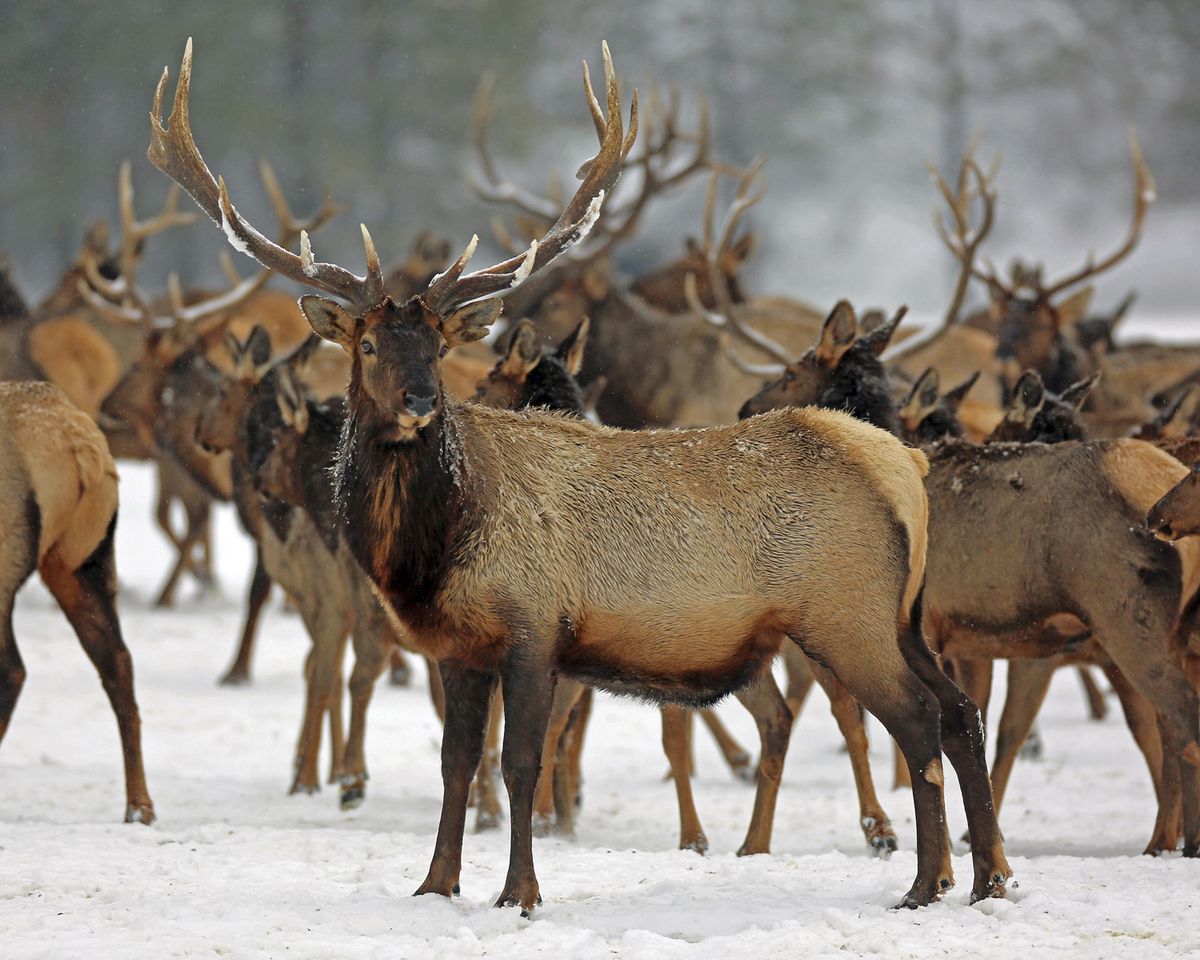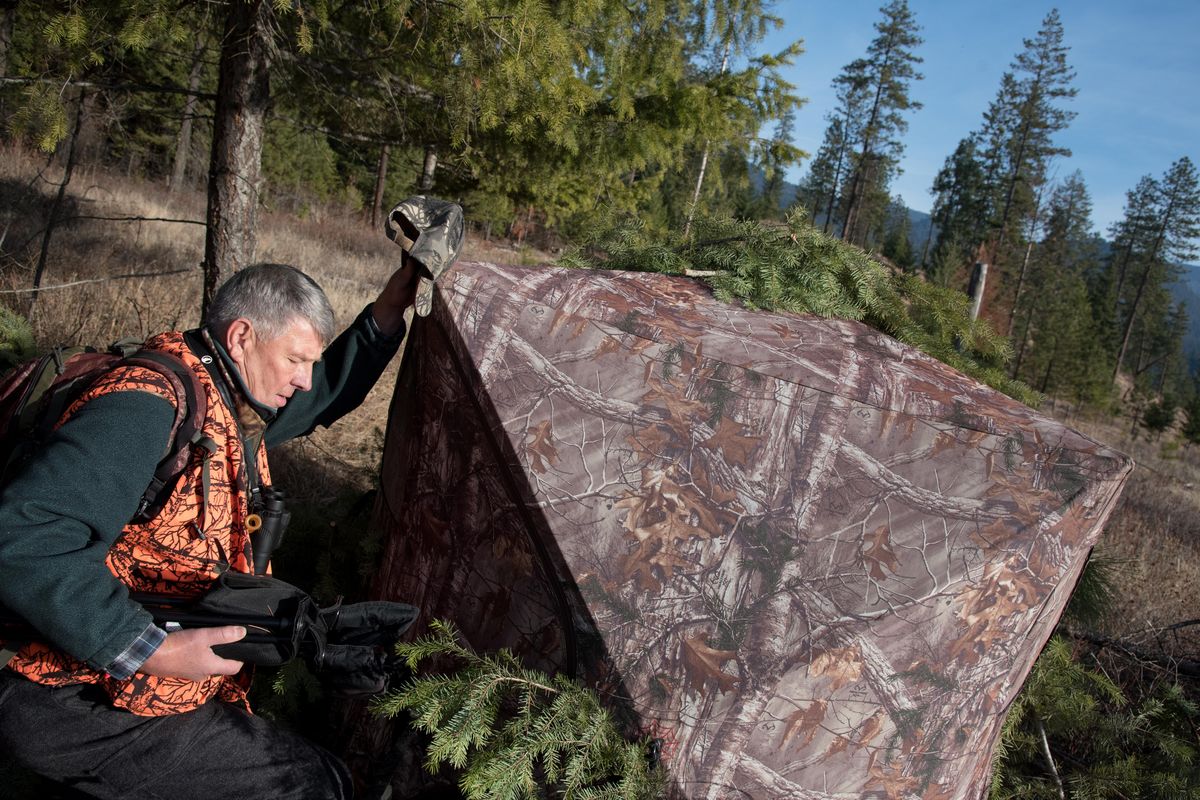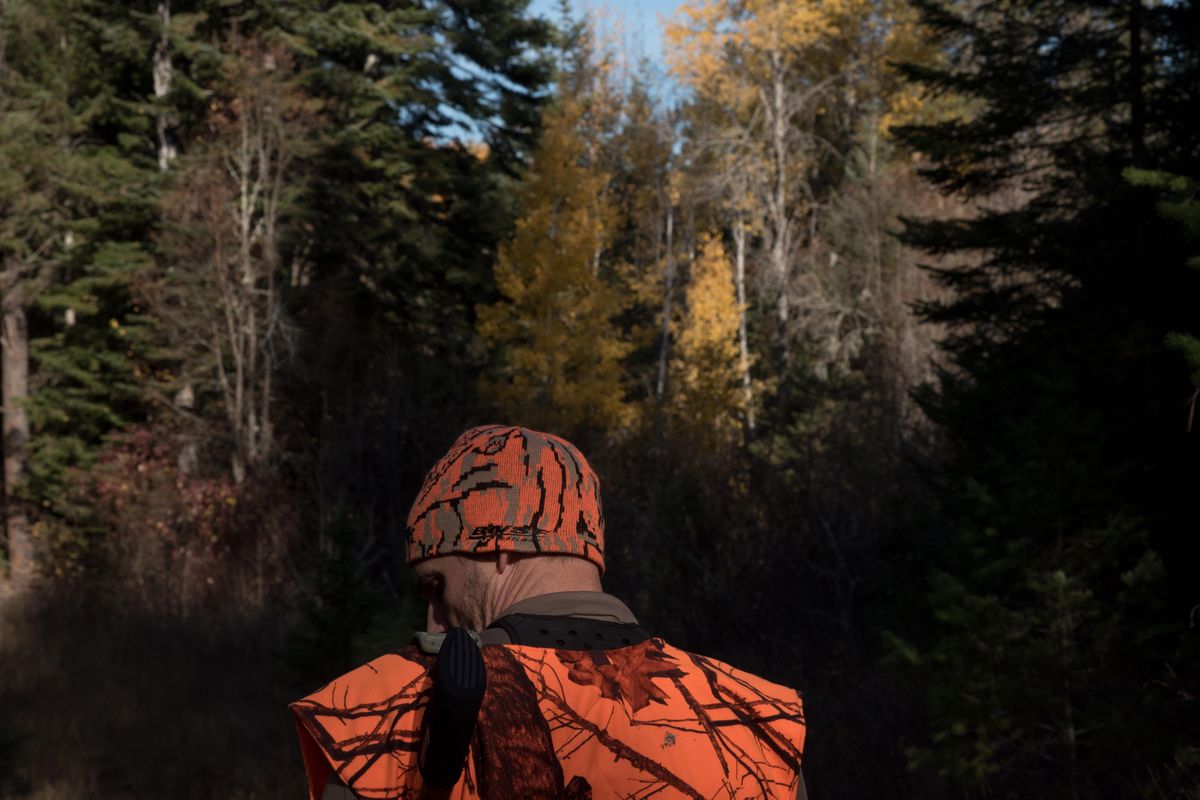S-R Hunting Outlook 2019: Where to go, what to hunt; Eastern Washington’s 2019 prospects

With the general hunting season opener for most of Washington about a month out, now is the time for the unprepared hunter to panic.
Sure, dedicated hunters have their spots lined up, scouted and (if you’re a bowhunter) hunted. But for most of us, as the temperature drops we find ourselves scanning our contact lists to see if we know any landowners in District 2 and driving aimlessly through public land in northeast Washington looking for deer sign.
While The Spokesman-Review won’t be helping you convince your uncle’s sister’s high school boyfriend’s brother to let you hunt on his 20 acres next to the Turnbull National Wildlife Refuge, we do have detailed information on where to hunt for what throughout northeast Washington.
John Andrews gets into a blind while hunting for deer on Nov. 18, 2018. (Eli Francovich / The Spokesman-Review)Buy a print of this photo
District 1
The mountains and valleys of District 1 (Game Management Units 101 through 121) offer the best whitetail hunting in Eastern Washington. With 37% of the land public, there’s plenty of opportunity for the enterprising hunter.
Deer: Consistency is the name of the game in District 1, at least when it comes to deer density and hunter strategy. The buck-to-doe ratio is “exactly the same” as it was last year (32 bucks per 100 does), District wildlife biologist Annemarie Prince said.
The mild start to the 2018-19 winter, followed by heavier snow later, didn’t seem to impact overall deer populations, she said.
“We didn’t get any reports of people finding any dead deer or anything like that,” she said.
Even though there was heavier snow later, it never got too crusty and everything “greened up really quickly.” Graduate students working on Washington’s ongoing predator-prey study have “got a ton of pictures of whitetails running through GMU 117” and others, she said.
Despite those hopeful predictions, Prince refrained from saying it would be a good harvest year.
“I thought last year would be a better hunting season than it was,” she said.
A dry and hot opening weekend followed by an unusually warm and dry late October may have reduced overall hunter success in 2018.
Last year, 4,668 deer (of both species) were harvested in District 1. That was a 7% decrease from 2017 when 5,034 deer were harvested. The five-year harvest average is 5,882 deer. In 2018, hunters put in 24 days of effort for a deer, five more days than in 2017.
Like always, scouting and a willingness to get away from roads are the biggest predictors of a successful hunt.
As for which GMUs to try, 121 (Huckleberry) and 108 (Douglas) led the pack with three-year average success rates of 34.4% and 33.8%, respectively.
They were closely followed by GMUs 105 (Kelly Hill, 31.4%), 117 (49 Degrees North, 28%) and 111 (Aladdin, 27.5%).
A more comprehensive rating system instituted by the Washington Department of Fish and Wildlife scores units based on success rate, hunter density and harvest per mile. By those metrics, GMUs 121 and 108 remain at the top of the heap.
Elk: District 1 is not known for its elk hunting, and 2019 is no different, Prince said. Overall elk numbers remained consistent between 2018 and 2019. As usual, most of those animals are staying in the valley bottoms, which are mostly privately owned land.
Like deer, elk numbers don’t seem negatively impacted by the 2018-19 winter.
Not that an elk can’t be taken in District 1 – it’s just hard to do. Prince said there are some elk hunters who have success year after year.
“They’ve found where the elk are,” she said. “It seems like our elk don’t move very much.”
In 2018, elk hunters took 204 animals, a 7% decrease in harvest from 2017. The five year average is 220. Hunter effort stayed consistent between 2018 and 2017 at about 82 days per kill.
Other species: In 2018, turkey hunters spent about nine days in the field and harvested 2,966 birds, an 11% increase in harvest over 2017.
“Turkey hunting is always good,” Prince said.
Few hunters specifically target black bears in District 1, instead hunting the bruins if they happen to come across them. In 2018, 181 black bears were killed. With a longer season in 2019, a bigger bag limit, harvest could increase in 2019.
Since 2018, all black bear hunters are required to take an online bear identification course (wdfw.wa.gov/hunting/requirements/bear-identification-testing). All successful bear hunters are required to turn in a tooth.
All hunters are encouraged to “really take their time and make sure there are no cubs around,” Prince said.
Fifty cougars were killed in District 1 in 2019, the same number as 2018.
For full District 1 prospects visit: wdfw.wa.gov/sites/default/files/publications/02103/district_1_hunting_prospects_2019.pdf
District 2
Three words: Private land access. That’s the key to success in District 2, district wildlife biologist Michael Atamian said. Hunters who have that access will likely find success. Without, it becomes much harder.
Deer: There are more mule deer in District 2 than District 1, although whitetails are still common. Mulies can be found in the southern and western portions of the district where the drier climate of the channeled scablands starts.
The most recent aerial flights estimate there are around 13,000 mule deer in the Washtucna area and 11,000 in the Odessa area.
The mule deer population has stayed relatively stable, although it’s still recovering from several harder winters and droughts, Atamian said. For example, 2014 and 2015 were relatively dry, drought years, which can be particularly hard on mule deer. A tougher 2018 winter led to some reports of winter kill
“If you’re a skier, you enjoyed (it) because you were skiing into April,” Atamian said. “But that’s not good for ungulates.”
He expects this to be a good year for fawn recruitment, perhaps leading to a full recovery. In 2019, hunters harvested 1,189 bucks, an increase over 2019 but still 15% lower than the 10-year average.
The most productive units were GMUs 136 (Harrington), 142 (Almota) and 139 (Steptoe).
It’s a similar story for whitetails, with the population still recovering from a 2015 blue tongue outbreak, Atamian said, followed by several tougher-than-normal winters and a small outbreak of Epizootic Hemorrhagic Disease in northwest Spokane County.
“They still haven’t recovered from that,” he said of the 2015 disease outbreak. “We’re still looking at lower whitetail population-wise.”
The most productive whitetail units were 139 (Steptoe) and 127 (Mica Peak).
Overall hunter success for both species averaged 29% in 2018, a decline of 13 percent from the previous 10-year average. Hunter effort decreased in all GMUs except 124 and 130 which saw increases. Overall hunters averaged 15 days/kill in 2018 compared to 13 days/kill for the previous 10-year average.
“The whitetail populations it’s going to come back. It’s just a matter of time,” Atamian said. “Right now, we’re still recovering. It was just slowed down by a couple hard winters.”
Elk: “Stable and sporadic” is how Atamian described the elk prospects in District 2. Like all hunting in the district, private land access is key. Some years the harvest rate for certain GMUs will hit 20% and other years drop to 5%.
“I associate that with the private land factor we have out here,” he said. “Success is as much about having the permission on the right place at the same time as the elk being there.”
The best units are consistently GMUs 124 (Mt. Spokane), 127 (Mica Peak) and 130 (Cheney), with hunters on 127 and 130 having the highest success. In the past few years, however, GMUs 136 and 139 have improved. Nearly one-third of all elk hunters in District 2 head to GMU 124 (Mt. Spokane), making it the most crowded area.
Elk seem to be expanding their range into GMUs 139 (Steptoe) and 142 (Almota) with harvest numbers increasing there the past five years.
“What’s the exact rhyme or reason for why that’s happening, I couldn’t give you a good reason for that,” Atamian said.
In District 2, any elk are fair game for hunters in an effort to keep the large ungulates from destroying agricultural land.
Hunter success has averaged 12% over the past decade and effort (days/kill) has averaged 41 days/kill. Both figures vary widely depending on the GMU. In District 2, there are more than 100 private properties enrolled in WDFW’s private land hunting program. While most of those are for deer and bird hunting, there are some open to elk hunters. For more information, visit geodataservices.wdfw.wa.gov/huntregs/.
Other species: Chukar and partridge hunting should be good in 2019. Over the past 10 years, harvest has averaged 1,791 birds a year. In 2018, harvest was 2,236, considerably above both the 10-year average and almost twice the 2017 harvest for both species.
Partridge are most common in Lincoln and Whitman counties and are most often seen in, and adjacent to, agricultural fields. There are few chukar in District 2. They are predominantly found along the breaks of the Snake River, where terrain is steep and rocky with limited public access from above. There is some access via U.S. Army Corps of Engineers land along the Snake River from below, but not all of the Corps lands allow hunting. See their website for details.
While not known for its waterfowl hunting, some hunters find success in perennial waterbodies or during high-precipitation years when shallow, seasonal lakes stick around and fields flood creating “duck and goose hot spots.”
Overall pheasant harvest has declined over the past decade, but harvest has gone up in the past two years, according to WDFW. The majority of pheasant hunting occurs in Whitman County, which has about three times the harvest and about two times more hunters than Lincoln or Spokane counties.
For full District 2 prospects visit: wdfw.wa.gov/sites/default/files/publications/02103/district_2_hunting_prospects_2019.pdf
District 3
Anchored by the Blue Mountains, District 3 is known for its elk herds.
But not this year. Long, hard winters and dry summers have likely lead to a decline in the elk numbers in the district, district wildlife biologist Paul Wik said. The bright spot is, deer numbers seem to be stable.
Deer: While a series of harder winters have hurt the elk population in District 3, deer seem to be doing OK, Wik said.
“Although we did have deer mortality from the winter, we don’t think our harvest is going to decline very much,” he said. “A very high percentage of our deer are in that agricultural grassland interface area.”
More forage and less snow at lower elevations means that there shouldn’t be an “overly noticeable” difference for hunters from last year. Last year’s deer population estimate was about 18,000, which was similar to the 2017 estimate. There are whitetail and mule deer throughout the district.
Traditionally, the most productive GMUs are 145 (Mayview), 178 (Peola), 181 (Couse) and 186 (Grand Ronde). These units also happen to be mostly private land. According to a WDFW analysis that considered hunter density, success and public access the No.1 GMU was 178. Hunters in that unit were successful 42% of the time, with on average, two hunters per square mile. The second-best GMUs by those metrics were 145 and 181.
Both boasted 40% success rates with about 1.5 hunters per square mile.
Elk: Don’t expect much. That’s the message from Wik when it comes to elk in 2019.
“There is probably no place for elk that is going to be really good,” he said. “I think people should go to the traditional places they like and enjoy the hunt.”
Since 2016, District 3’s elk population has decreased 25%, according to WDFW’s most recent survey which was completed early this year. For reference, in 2016, the estimated population was 5,717. In 2019, it dropped to 4,015 elk. This year’s survey documented 23.8 calves per 100 cows. Ideally, Wix said, that ratio would be 30 calves per 100 cows.
“We have found numerous winter kill in the 2016-17 winter,” he said. “We did have numerous elk dying of starvation this year as well.”
A number of droughts have compounded the issue. Last fall, for instance, was dry and hot. Fall forage didn’t green and elk weren’t able to fatten up in preparation for the winter.
Bull tags haven’t been reduced for the 2019 season, but hunters should expect reduced opportunity in 2020.
“Elk don’t bounce back quickly like whitetail,” Wik said. “This year there are not going to be a lot of spikes on the landscape.”
Other species: “Chukars look good,” Wik said. “Definitely a lot of chukar broods out there right now.”
Pheasant populations, on the other hand, seem to be “status quo,” he said. As always, there are plenty of turkeys.
For full District 3 prospects visit: wdfw.wa.gov/sites/default/files/publications/02103/district_3_hunting_prospects_2019.pdf







